On the right bike and right commute, normal street shoes are ideal. They enable you to switch instantly from cycling to walking or vice versa. If you want to ride further or faster, however, dedicated cycling shoes have plenty to recommend them.
Updated July 2019
On the right bike and right commute, normal street shoes are ideal. However some cycling shoe benefits include the fact they enable you to switch instantly from cycling to walking, or vice versa.
If you want to ride further or faster, however, dedicated cycling shoes have plenty going for them: the stiffer soles transmit power more effectively and more comfortably; your feet won’t slip off the pedals by accident; and your smartest shoes will remain spatter-free and unscratched.
Most cycling shoes are aimed at road racing cyclists or mountain bikers – and they look it, with an obvious sports shoe aesthetic.
Some are more casual and can be worn off the bike too - even in the office if the dress code isn’t too strict.
Whether you change shoes at work or keep your bike shoes on all day, mountain bike shoes are better than road racing shoes for commuters. That’s because two-bolt mountain bike shoe cleats are smaller and recessed. As the cleat doesn’t protrude any further than the sole, you can walk normally in them. Road cleats are bigger and sit proud of the sole, so you can only hobble a few steps.
Furthermore, the pedals that mountain bike cleats clip into are double-sided. This means that when you’re setting off from the traffic lights, you can tread down onto the pedal and ride off right away, rather than pedalling with one leg while you try to secure your other foot.
Other features that are useful when buying cycling shoes for commuting include weather protection and subtle reflective detailing. Unless your bike has a chainguard, some way of restraining or shortening the laces to keep them out of the chain is useful too.
Any two-bolt cleats will fit to any two-bolt shoes, so you can use whichever clipless pedal system you prefer. The cleats come with the pedals not the shoes, although you can buy cleats separately. The most popular systems are Shimano SPD, Time ATAC, and Crank Brothers Eggbeater. In all three, you tread down onto the pedal to open the sprung ‘jaws’ so that they clasp the cleat, and then twist your heel outwards to release it.
Practise engaging and disengaging your road cycling shoes from the pedals before heading out into traffic. Many pedals have a screw that adjusts the spring tension; slackening this off allows easier pedal release. Even better, Shimano offer ‘multi-release’ cleats, identifiable by a big letter ‘M’ on the bottom of the cleat. With this, you can pull your foot upwards hard and still exit the pedal, so you’re less likely to end up lying on the floor still attached to your bike.
Both Time and Crank Brothers pedals allow a greater range of foot movement while the cleat is connected to the pedal – known as float. Plenty of riders, and especially those with knee problems, prefer this.
When cycling, you have three contact areas with your bike.
-
Correct handlebar set-up is essential for safe handling, comfort and optimal aerodynamics.
-
Choosing the right saddle and positioning it correctly can genuinely make the difference between cycling bliss and riding misery.
-
The third contact point is your pedals and these are what link the bike’s engine, your legs, to the bike. In just an hour of cycling, you could be performing well over 5000 pedal strokes, so it’s essential to get this key area right.
Why Wear Cycling Shoes
Many novices ride with flat pedals and trainers and although this is fine for short recreational rides, the inefficiency and potential discomfort makes it a poor choice for more serious cycling. The main problem with cycling in trainers is that they’re too flexible. This means with every pedal stroke some power is lost as your shoe flexes.
Thinking about the 5000 pedal strokes the average cyclist does in an hour, this lost energy and resulting lost speed soon adds up. The flexibility of trainers also means your feet are constantly having to flex, which can lead to soreness and fatigue. You’ll feel a large amount of pressure through soft soled shoes which can also lead to soreness and hot spots developing.
Stiff soled cycling shoes solve all these problems and ensure that the maximum amount of power finds its way from your legs, into the pedals, and ultimately onto the road. The rigid soles are made from nylon or glass fibre composites in cheaper shoes, but higher end cycling shoes make use of the high strength, amazing stiffness and low weight of carbon fibre. A combination of Velcro straps and ratchet mechanisms ensure that your feet are securely but comfortably held within the shoes and ventilation panels prevent overheating. The uppers are lightweight and fast drying, and materials used range from synthetic fabrics to yak and kangaroo leather.
Clipless Pedals
For a long time cyclists have been aware of the benefits of having their feet physically attached to their pedals. It allows for a far more even and efficient pedal stroke and, when descending, especially when riding off-road or in wet conditions, keeps your feet securely in place.
The traditional method was to use metal cages and leather straps known as toe-clips but in the mid-eighties French company Look developed clipless pedals using technology derived from ski bindings. A cleat bolted to the sole of the shoe engages with a spring mechanism on the pedal and is held in place. A sideways twisting action disengages the cleat and allows the rider to remove their feet from the pedals.
Learning to ride clipless
Beginners are often put off by the idea of having their feet attached to their bike, but becoming confident with clipless pedals takes hardly any time at all. If your pedals allow you to adjust the release tension, dial it right down while you’re learning. Take your bike somewhere free of traffic and just practice clipping in and out. After 20-30 minutes of practice it will become second nature and you can hit the roads for real.
Setting up cleats
By following this simple process, recommended by Phil Burt, lead physiotherapist with the Great Britain Cycling Team and consultant physiotherapist to Team Sky (now Team INEOS), you can make sure your cleats are setup correctly.
Fore and Aft
- With your foot in your shoes, feel along the inside of your foot for the large bony prominence at the base of your big toe. Use a marker pen to mark its position.

- Do the same with the outside of your foot for the prominence at the base of your little toe.

- Take off the shoe and draw two parallel lines across the base of the shoe. The first straight across from the first mark and the second from the second mark.

- The midpoint between these two lines indicates the fore and aft position for the centre of the cleat.
Rotation
-
Once you know the fore and aft position, if you position the cleat in the middle of the shoe based on this, you’ll have a neutral setup which is a good place for the majority of riders to start, especially if you’ve chosen cleats and pedals that offer a reasonable amount of float.
-
However, look at the way you stand and walk. If you tend to have your toes pointing out, slightly rotate the alignment of your cleats to allow for this. Similarly, if you have a toes inward stance, rotate your cleats to accommodate this.
Stance width
-
Although bottom bracket widths are standard, cyclists are not. Once you have adjusted, if necessary, for rotation, look for signs that you may need to alter width away from neutral. Are you catching your cranks with your heels or do your cranks or the heels of your shoes show signs of scuffing?
-
If so, move the cleats in towards the bike to move your feet out.
Types of cycling shoes
There are several different types of cycling shoe to consider depending on the type of cycling you mainly do.
Road cycling shoes
Light and extremely stiff, road shoes are designed to maximise power transfer to the pedals. Top end models will have full carbon soles and finely adjustable fitting systems. Some brands even allow you to custom fit them by preheating your oven and then moulding to your feet. The cleats tend to be fairly wide to spread pressure and, as they stand proud of the sole, are precarious to walk in.
Cross country mountain bike shoes
The uppers look very similar to a performance road shoe but will be slightly more robust and the sole will have rubber grips to aid running off the bike on rough surfaces. Many also have screw in holes for two football style studs on the toe for when it’s really slippery. The cleats are recessed, tend to be smaller than road cleats and allow more float. The action of engaging and disengaging the cleats with the pedals serves to clear mud and prevents them clogging up. This style of shoe is also used for cyclo-cross.
Leisure / mountain bike / commuting
These all have the same recessed cleats as a racing mountain biking shoe, but are styled to look more like a regular shoe, trainer or hiking boot. The sole is usually slightly more flexible than a full-on race shoe, making walking for extended periods much more comfortable.
Triathlon shoes
These are similar to a road shoe but have a number of multi-sport specific features. A large single velcro strap that opens away from the cranks allows easier on the bike fastening and unfastening. A large heel loop also facilitates getting your feet in and out of the pedals while rolling out of or into transition. Heel bumpers prevent the shoe getting damaged bouncing on the road as you run with it still attached from the bike. Drainage holes lets water out from the swim, while multiple venting panels aid drying and the inners are soft for sock free riding.
Winter booties and overshoes
Cold feet can make winter riding uncomfortable but fortunately, winter booty versions of both road and mountain biking shoes are available. These are higher cut and are both insulated and waterproof. It’s also possible to get overshoes for your regular shoes. These range from full-on thick waterproof neoprene overshoes for winter riding to thin lycra overshoes for spring, autumn or for gaining a tiny aerodynamic edge. Another option for those mixed spring and autumn days are toe covers which, by covering up your shoes’ ventilation panels, make a surprisingly big difference.
Here are some of the best cycling shoes you can get, if you want some inspiration of which cycling shoes to buy:

Quoc Pham Tourer
They're not cheap, but Quoc Pham's hand made leather shoes are the epitome of subtlety. They certainly don't shout “cyclist!”, unless you're familiar with cycling shoes of the 1950s. Bringing the design up to date, the Tourer has a chunky rubber sole and fittings for cleats – there's also the Fixed, with a flat sole for use with traditional toeclips.
www.quocpham.co.uk
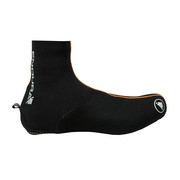
Endura Deluge Overshoes
Waterproof shoes are available, but they're expensive. Neoprene overshoes like the Deluge go over your cycling shoes and keep the worst of the elements off, keeping your feet warm even if there's rain and puddles. Most overshoes are designed to fit over slim road-style shoes – seek out bigger ones if you're using chunkier shoes.
www.endurasport.co.uk
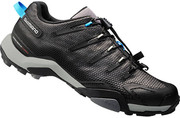
Shimano MT44
The MT44 is a great example of the “rugged trainer” style of cycling shoe. At a glance it could be an approach shoe from the likes of Merrell or Salomon, but inside there's a stiffened sole and clipless fittings. Speed laces mean no knots to tie, and the laces hook safely out of the way.
www.madison.co.uk

Five Ten District
Five Ten made its name in climbing shoes, and it uses the same super-sticky rubber on the soles of its bike shoes. A lot of Five Ten offerings are pitched at mountain biking, and look it, but the District is a more subtle, skate-style shoe that won't look out of place with jeans.
www.bigstone.co.uk
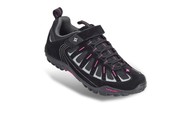
Specialized Women's Tahoe
Specialized's Body Geometry design makes for a range of comfortable, well-fitting shoes. The Tahoe is its crossover bike/hike shoe, with a chunky sole and suede/mesh upper. It's clipless pedal-ready. A Velcro strap adds security and keeps the laces out of the way. There's a men's version too.
www.specialized.com
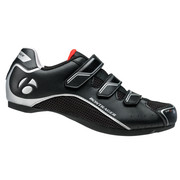
Bontrager Solstice
The Solstice comes at the “walkable cycling shoe” concept from a different angle, with an upper modelled on a conventional race shoe but equipped with a thicker sole. You wouldn't want to walk a long way in it, but it's a good solution to having a “proper” cycling shoe that doesn't make you walk like a duck.
www.bontrager.com
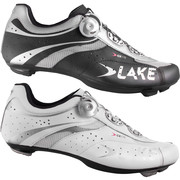
Lake CX175
Riding for an hour rather than just across town? You might want to look beyond “crossover” shoes and get yourself some more uncompromising footwear. Lake's CX175 has a Boa dial and monofilament line for fast, secure fastening and a sole ready for a road clipless system. They're more expensive than some shoes, but good value for their type.
www.todayscyclist.co.uk
Check your Cyclescheme savings


Comments: